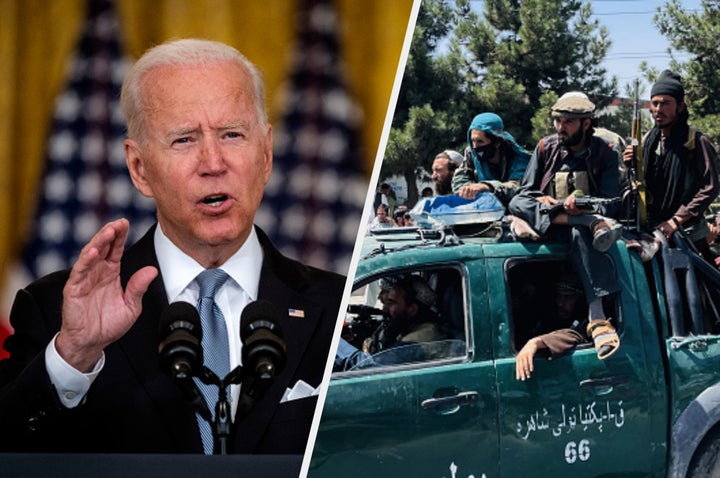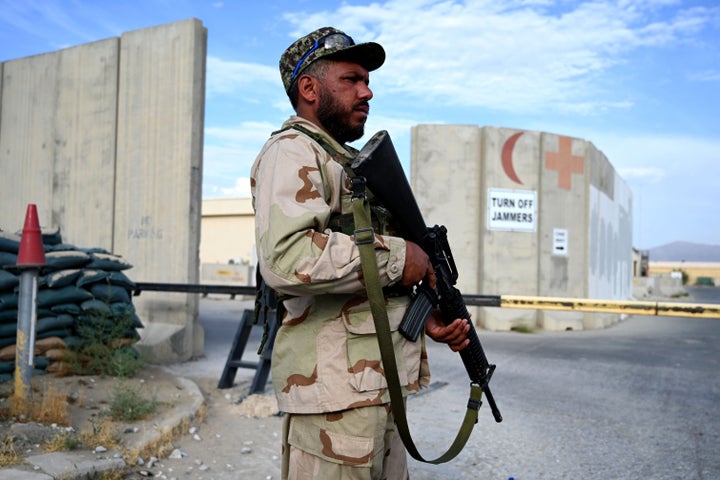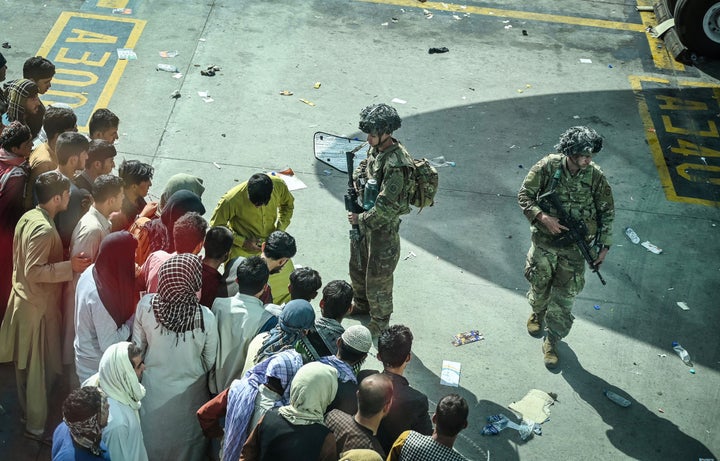The Taliban has swept through Afghanistan in less than 10 days, after two decades of western assistance.
But US officials expected Kabul to fall in 90 days, rather than less than 10 – so why did it all unravel so quickly?

What has Biden said about the Afghanistan crisis?
Despite the Taliban’s overwhelming victory – which undid two decades of US work – Biden said on Monday: “I stand squarely behind my decision.”
Biden added: “There was never a good time to withdraw US forces.”
However, last month the president promised the press that it was “highly unlikely” the Taliban would takeover again.
He continued: “If anything, the developments of the past week reinforce that ending US military involvement in Afghanistan now was the right decision.
“American troops cannot and should not be fighting in a war and dying in a war that Afghan forces are not willing to fight for themselves.”
The president said: “The truth is: This did unfold more quickly than we anticipated. So what’s happened?
“Afghanistan political leaders gave up and fled the country. The Afghan military gave up, sometimes without trying to fight.”
Biden added: “We gave them every chance to determine their own future. We could not provide them will the will to fight for that future.”

Is the Afghan military at fault?
The US has spent more the $2 trillion (£1.45 trillion) in Afghanistan since 2001.
The Afghan National Army was also funded and trained with $89 billion (£64 billion) from the US taxpayer.
The Afghan military has been assisted by Nato coalition forces too, and the troops outnumbered the Taliban.
However, the Afghans depended on allied forces for morale, too.
John Ciorciari, director of international police from the University of Michigan, told CNBC Afghanistan’s fall shows “how utterly dependent the Afghan state was on the US-led coalition, materially and psychologically”.
He added: “As the dust settles, many US-trained fighters will likely regroup along ethnic lines to fight again.”

Why was intelligence inaccurate?
A former intelligence official and US Marine suggested that the US forces were not ready for the Taliban’s lightning strike.
They told CNBC: “While the end result and bloodletting once we left was never in doubt, the speed of collapse is unreal.”
Bill Roggio, senior fellow at the Foundation for Defence of Democracies also claimed the US military intelligence failed when assessing the situation in Afghanistan.
Biden told the media the Taliban were not expected to take control again so soon, and US officials thought Afghan forces would hold out for six months to a year.
Roggio claimed the Taliban had been planning a “massive offensive” since May, and then their efforts snowballed when the US troops confirmed they were withdrawing.
“Nobody wanted to be the last man standing after the others gave up”
- Stephen Biddle, professor of international and public affairs, Columbia University
Why did many Afghan forces surrender?
Despite receiving training and weapons from the US Army, many Afghan troops surrendered to the Taliban as the militants made their way through each Afghanistan province.
Research fellow for land warfare and military sciences at the Royal United Services Institute, Jack Watling, said: “The Taliban would infiltrate urban areas, assassinating key people like pilots, threatening the families of commanders, saying if you capitulate, you’ll save your family.
″A lot of people, because they lacked confidence that Kabul would be able to save them, capitulated.”
He added that an increasing number of people chose this option, “so there was very little fighting, which is why it suddenly happened so fast”.
Watling added: “The speed is not a reflection of military capability, it is a reflection of a collapse in will to fight.”
This was accelerated by the news of the US troops’ withdrawal.
International and public affairs professor Stephen Bidden from Columbia University said: “Nobody wanted to be the last man standing after the others gave up.”
Was corruption a factor?
Watling maintained that the Afghan military was compromised of many units which are “systemically corrupt” with “no effective command and control”.
He claimed their equipment was often “stolen or sold off” to the Taliban for money, and they were rarely aware how many troops were actually in their unit due to regular desertions.
He said: “The soldiers in many cases have not been fed very well, very rarely been paid and been on duty for a long time away from home.. and were not well led.”
There had been a loss of approximately 40 Afghan soldiers a day in recent years.
A former US intelligence officer told CNBC: “We basically supported a hodgepodge of ethnic minorities, who never had the capability of unifying the country.”
The Afghan government was also undermined by the deal led by the Trump administration in 2020.
Then-US president Donald Trump did brokered a cease-fire with the Taliban on the basis that troops would limit action against the militants – but did not include the Afghan government in negotiations.
Morale also waned when it became clear US forces were leaving.
Why was the Taliban takeover even faster than the US’ in 2001?
The Taliban took over Afghanistan faster than the US managed to wrestle power back in 2001, which has stunned many experts in the field.
While it took the US and Nato allies from September until November 2001 to force the Taliban out of control, it took the Taliban less than 10 days to oust the Afghan government.
Director of Scowcroft Middle East Security Initiative at the Atlantic Council, Kirsten Fontenrose, claimed the Taliban regrouped in years since falling from power.
She told CNBC: “The US withdrawal is not the reason the Afghan government was outmanoeuvred.”
“They’ve become much more adept…militarily and non-militarily in terms of pursuing the same objective they have – which is establishing an Islamic emirate in Afghanistan.”
She said the militants have cut off the supply lines the government forces needed to fight off the Taliban from Kabul.
She added they now utilised social media, with “coercion” to pressure local tribal leaders, and “text message campaigns to threaten local Afghans working with the US and with other foreign efforts”.
